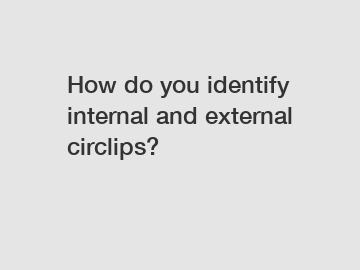How do you identify internal and external circlips?
Welcome to our comprehensive guide on identifying internal and external circlips! Whether you're an amateur repair enthusiast or a seasoned professional, understanding the differences between these essential components is crucial. In this article, we'll delve into the realms of circlips, covering their definitions, purpose, and most importantly, how to distinguish between internal and external variants. So grab your circlip pliers, embark on this journey with us, and unlock the secrets behind these small but mighty rings!
Section 1: What are Circlips? (200 words).
Circlips, also known as retaining rings or snap rings, are commonly used mechanical fasteners. Their inventive design allows for easy installation and removal, providing critical support to keep various components securely in place. By fitting into specially shaped grooves on shafts or inside bores, circlips prevent lateral movement, axial displacement, and ensure optimal performance in diverse applications. From the automotive industry to manufacturing and machinery, circlips play an indispensable role in maintaining functionality and structural integrity.

Section 2: Internal Circlips: The Enigmatic Rings (200 words).
Internal circlips attach to grooves within bores, serving as restraining devices that prevent axial movement of components. Their compact design and inward-facing ends allow for easy installation since they can be compressed for placement within the grooves. To identify internal circlips, look for their characteristic curved, hook-like shape, which snugly fits into the groove but retains flexibility. With the assistance of reliable circlip pliers, be confident in your ability to securely fix these rings in place.
Section 3: External Circlips: Embrace the Power of Confinement (200 words).
External circlips, in contrast to their internal counterparts, are fitted outside of components such as shafts or pins. They exert outward pressure against the groove walls, creating a barrier against unintended displacement. Recognizing external circlips is as easy as spotting their open-ended structure. These rings feature small protrusions, called lugs or ears, which allow circlip pliers to grip and manipulate them effectively. Mastering the art of external circlip installation is a valuable skill when it comes to equipment repair or assembly tasks.
Section 4: Choosing the Right Circlip Pliers (150 words).
When working with circlips, a reliable pair of circlip pliers becomes your trusty sidekick. Circlip pliers come in different styles for both external and internal circlips, enabling smooth and hassle-free operations. The key to successful circlip handling lies in selecting the appropriate pliers for your task. For external circlips, opt for bent-nose pliers designed to easily reach and grip the lugs or ears for efficient manipulation. When handling internal circlips, straight-nosed pliers are the go-to choice, offering optimal leverage and control.
Conclusion (50 words).
By now, we hope this guide has familiarized you with the contrasting features of internal and external circlips while shedding light on their crucial roles within mechanical systems. Armed with the knowledge to distinguish between the two, paired with the right circlip pliers, you're equipped to tackle any circlip-related challenge that comes your way! Get ready to step into the world of precision, efficiency, and expert circlip handling.
If you are looking for more details, kindly visit Brass Hammer manufacturer, Non-Sparking Cutting Tools, Non-Sparking Striking Tools.